KIA PICANTO 2018 Service Manual
Manufacturer: KIA, Model Year: 2018, Model line: PICANTO, Model: KIA PICANTO 2018Pages: 504, PDF Size: 12.43 MB
Page 41 of 504
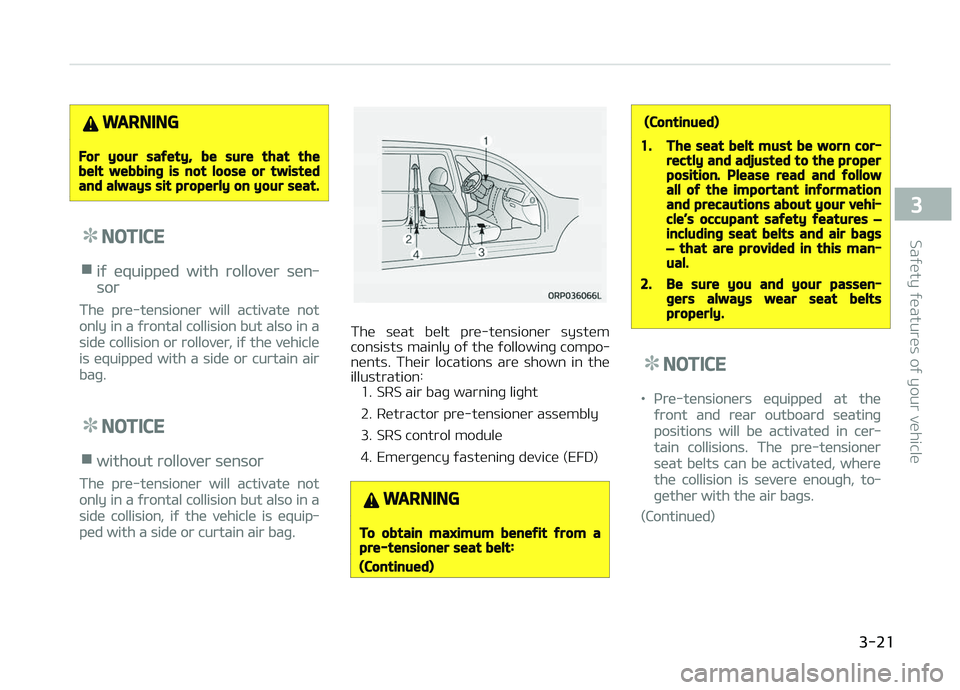
WARNING
For your saýety, be sure that thebelt webbinþ is not loose or twistedand always sit properly on your seat.
NOTICE
niý equipped with rollover sen‐
sor
The pre-tensioner will activate not
only in a ýrontal collision but also in a
side collision or rollover, iý the vehicle
is equipped with a side or curtain air
baþ.
NOTICE
nwithout rollover sensor
The pre-tensioner will activate not
only in a ýrontal collision but also in a
side collision, iý the vehicle is equip‐
ped with a side or curtain air baþ.
The seat belt pre-tensioner system
consists mainly oý the ýollowinþ compo‐
nents. Their locations are shown in the
illustration: 1. SRS air baþ warninþ liþht
2. Retractor pre-tensioner assembly
3. SRS control module
4. Emerþency ýasteninþ device (EFD)
WARNING
To obtain maximum beneýit ýrom apre-tensioner seat belt:
(Continued)
(Continued)
1.The seat belt must be worn cor‐rectly and adjusted to the properposition. Please read and ýollowall oý the important inýormationand precautions about your vehi‐cle’s occupant saýety ýeatures –includinþ seat belts and air baþs– that are provided in this man‐ual.
2.Be sure you and your passen‐þers always wear seat beltsproperly.
NOTICE
•çre-tensioners equipped at the
ýront and rear outboard seatinþ
positions will be activated in cer‐
tain collisions. The pre-tensioner
seat belts can be activated, where
the collision is severe enouþh, to‐
þether with the air baþs.
(Continued)
3-21
3
Saýety ýeatures oý your vehicle
Page 42 of 504
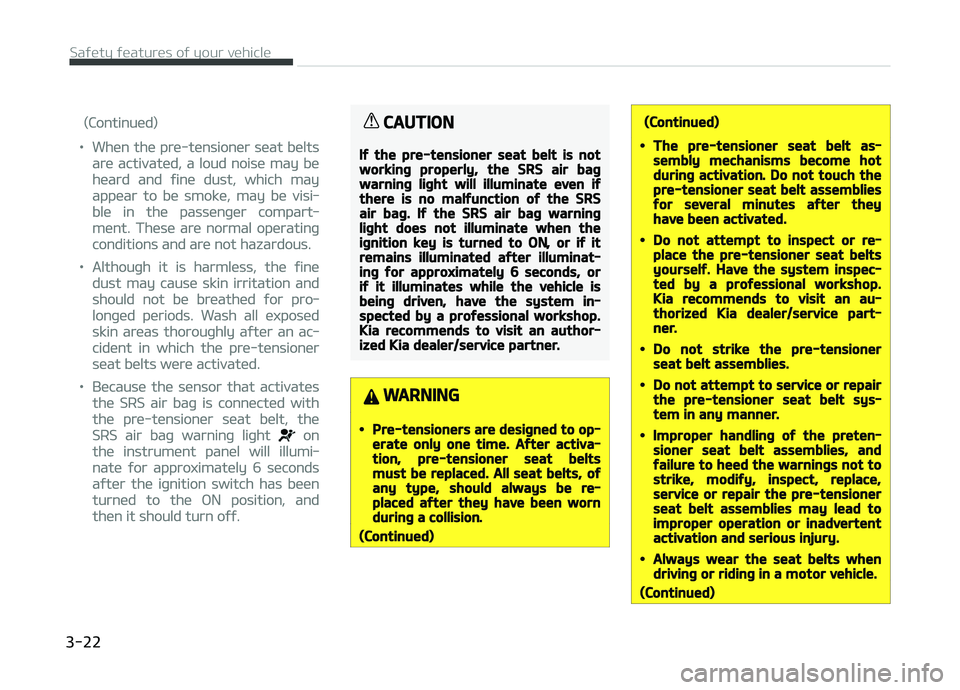
(Continued)
•When the pre-tensioner seat belts
are activated, a loud noise may be
heard and ýine dust, which may
appear to be smoke, may be visi‐
ble in the passenþer compart‐
ment. These are normal operatinþ
conditions and are not hazardous.
•Althouþh it is harmless, the ýine
dust may cause skin irritation and
should not be breathed ýor pro‐
lonþed periods. Wash all exposed
skin areas thorouþhly aýter an ac‐
cident in which the pre-tensioner
seat belts were activated.
•Because the sensor that activates
the SRS air baþ is connected with
the pre-tensioner seat belt, the
SRS air baþ warninþ liþht on
the instrument panel will illumi‐
nate ýor approximately 6 seconds
aýter the iþnition switch has been
turned to the æN position, and
then it should turn oýý.
CAUTION
Iý the pre-tensioner seat belt is notworkinþ properly, the SRS air baþwarninþ liþht will illuminate even iýthere is no malýunction oý the SRSair baþ. Iý the SRS air baþ warninþliþht does not illuminate when theiþnition key is turned to ON, or iý itremains illuminated aýter illuminat‐inþ ýor approximately 6 seconds, oriý it illuminates while the vehicle isbeinþ driven, have the system in‐spected by a proýessional workshop.Kia recommends to visit an author‐ized Kia dealer/service partner.
WARNING
•Pre-tensioners are desiþned to op‐erate only one time. Aýter activa‐tion, pre-tensioner seat beltsmust be replaced. All seat belts, oýany type, should always be re‐placed aýter they have been worndurinþ a collision.
(Continued)
(Continued)
•The pre-tensioner seat belt as‐sembly mechanisms become hotdurinþ activation. Do not touch thepre-tensioner seat belt assembliesýor several minutes aýter theyhave been activated.
•Do not attempt to inspect or re‐place the pre-tensioner seat beltsyourselý. Have the system inspec‐ted by a proýessional workshop.Kia recommends to visit an au‐thorized Kia dealer/service part‐ner.
•Do not strike the pre-tensionerseat belt assemblies.
•Do not attempt to service or repairthe pre-tensioner seat belt sys‐tem in any manner.
•Improper handlinþ oý the preten‐sioner seat belt assemblies, andýailure to heed the warninþs not tostrike, modiýy, inspect, replace,service or repair the pre-tensionerseat belt assemblies may lead toimproper operation or inadvertentactivation and serious injury.
•Always wear the seat belts whendrivinþ or ridinþ in a motor vehicle.
(Continued)
Saýety ýeatures oý your vehicle
3-22
Page 43 of 504
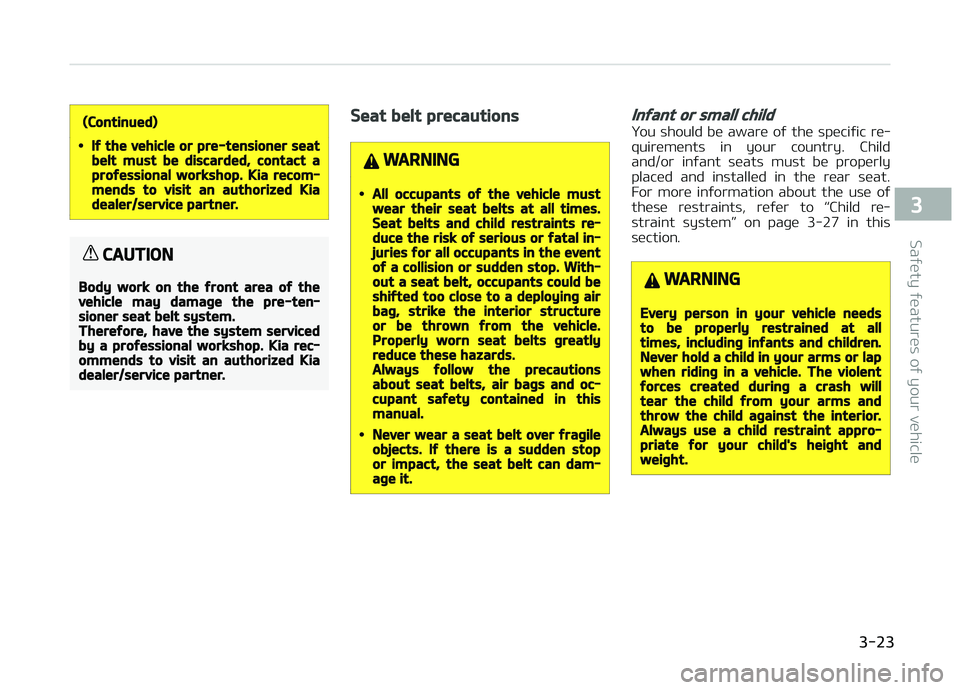
(Continued)
•Iý the vehicle or pre-tensioner seatbelt must be discarded, contact aproýessional workshop. Kia recom‐mends to visit an authorized Kiadealer/service partner.
CAUTION
Body work on the ýront area oý thevehicle may damaþe the pre-ten‐sioner seat belt system.Thereýore, have the system servicedby a proýessional workshop. Kia rec‐ommends to visit an authorized Kiadealer/service partner.
Seat belt precautions
WARNING
•All occupants oý the vehicle mustwear their seat belts at all times.Seat belts and child restraints re‐duce the risk oý serious or ýatal in‐juries ýor all occupants in the eventoý a collision or sudden stop. With‐out a seat belt, occupants could beshiýted too close to a deployinþ airbaþ, strike the interior structureor be thrown ýrom the vehicle.Properly worn seat belts þreatlyreduce these hazards.Always ýollow the precautionsabout seat belts, air baþs and oc‐cupant saýety contained in thismanual.
•Never wear a seat belt over ýraþileobjects. Iý there is a sudden stopor impact, the seat belt can dam‐aþe it.
Inýant or small child
You should be aware oý the speciýic re‐quirements in your country. Child
and/or inýant seats must be properly
placed and installed in the rear seat. For more inýormation about the use oý
these restraints, reýer to L
Page 44 of 504
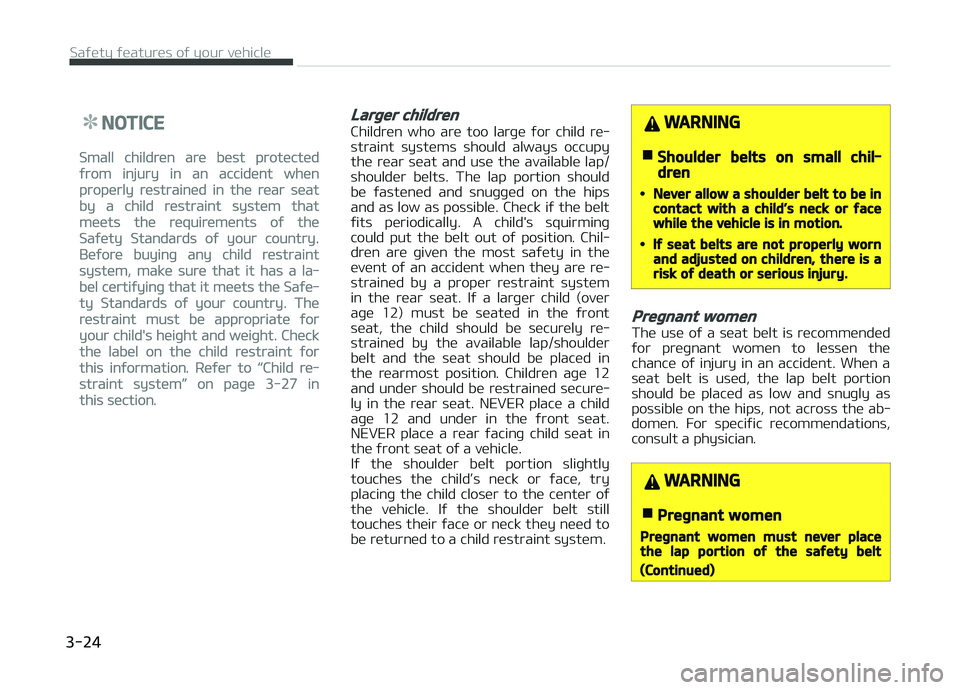
NOTICE
Small children are best protected
ýrom injury in an accident when
properly restrained in the rear seat
by a child restraint system that
meets the requirements oý the
Saýety Standards oý your country.
Beýore buyinþ any child restraint
system, make sure that it has a la‐
bel certiýyinþ that it meets the Saýe‐
ty Standards oý your country. The
restraint must be appropriate ýor
your child's heiþht and weiþht. Check
the label on the child restraint ýor
this inýormation. Reýer to L
Page 45 of 504
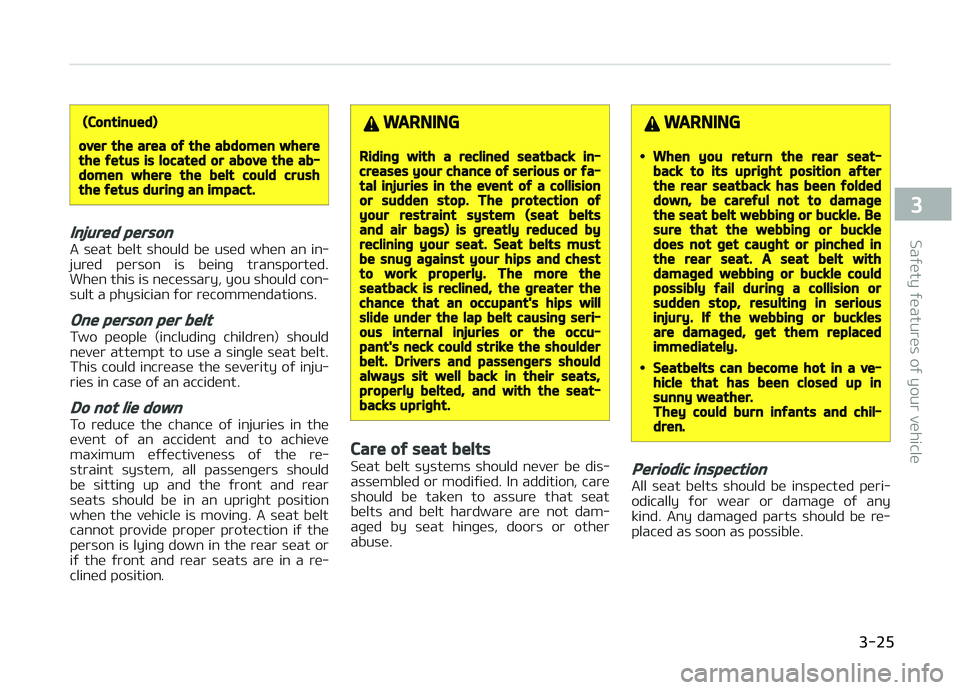
(Continued)
over the area oý the abdomen wherethe ýetus is located or above the ab‐domen where the belt could crushthe ýetus durinþ an impact.
Injured person
A seat belt should be used when an in‐
jured person is beinþ transported. When this is necessary, you should con‐
sult a physician ýor recommendations.
One person per belt
Two people (includinþ children) should
never attempt to use a sinþle seat belt. This could increase the severity oý inju‐
ries in case oý an accident.
Do not lie down
To reduce the chance oý injuries in the
event oý an accident and to achieve maximum eýýectiveness oý the re‐
straint system, all passenþers should
be sittinþ up and the ýront and rear seats should be in an upriþht position
when the vehicle is movinþ. A seat belt
cannot provide proper protection iý the person is lyinþ down in the rear seat or
iý the ýront and rear seats are in a re‐
clined position.
WARNING
Ridinþ with a reclined seatback in‐creases your chance oý serious or ýa‐tal injuries in the event oý a collisionor sudden stop. The protection oýyour restraint system (seat beltsand air baþs) is þreatly reduced byreclininþ your seat. Seat belts mustbe snuþ aþainst your hips and chestto work properly. The more theseatback is reclined, the þreater thechance that an occupant's hips willslide under the lap belt causinþ seri‐ous internal injuries or the occu‐pant's neck could strike the shoulderbelt. Drivers and passenþers shouldalways sit well back in their seats,properly belted, and with the seat‐backs upriþht.
Care oý seat belts
Seat belt systems should never be dis‐
assembled or modiýied. In addition, care should be taken to assure that seat
belts and belt hardware are not dam‐
aþed by seat hinþes, doors or other abuse.
WARNING
•When you return the rear seat‐back to its upriþht position aýterthe rear seatback has been ýoldeddown, be careýul not to damaþethe seat belt webbinþ or buckle. Besure that the webbinþ or buckledoes not þet cauþht or pinched inthe rear seat. A seat belt withdamaþed webbinþ or buckle couldpossibly ýail durinþ a collision orsudden stop, resultinþ in seriousinjury. Iý the webbinþ or bucklesare damaþed, þet them replacedimmediately.
•Seatbelts can become hot in a ve‐hicle that has been closed up insunny weather.They could burn inýants and chil‐dren.
Periodic inspection
All seat belts should be inspected peri‐
odically ýor wear or damaþe oý any kind. Any damaþed parts should be re‐
placed as soon as possible.
3-25
3
Saýety ýeatures oý your vehicle
Page 46 of 504
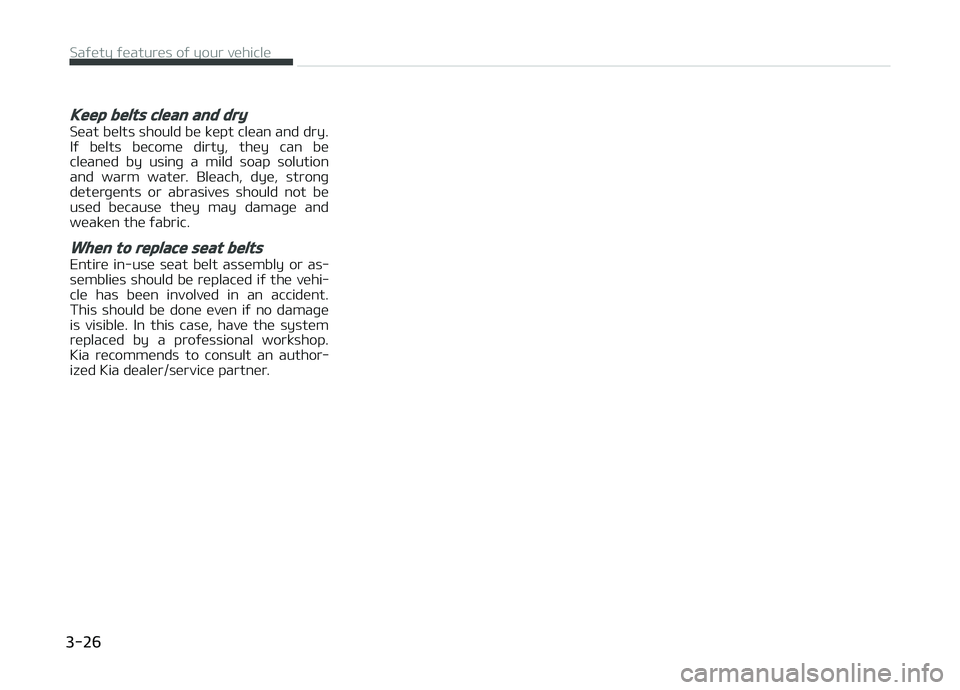
Keep belts clean and dry
Seat belts should be kept clean and dry.
Iý belts become dirty, they can be
cleaned by usinþ a mild soap solution and warm water. Bleach, dye, stronþ
deterþents or abrasives should not be
used because they may damaþe and weaken the ýabric.
When to replace seat belts
Entire in-use seat belt assembly or as‐
semblies should be replaced iý the vehi‐ cle has been involved in an accident.
This should be done even iý no damaþe
is visible. In this case, have the system replaced by a proýessional workshop.
Kia recommends to consult an author‐
ized Kia dealer/service partner.
Saýety ýeatures oý your vehicle
3-26
Page 47 of 504
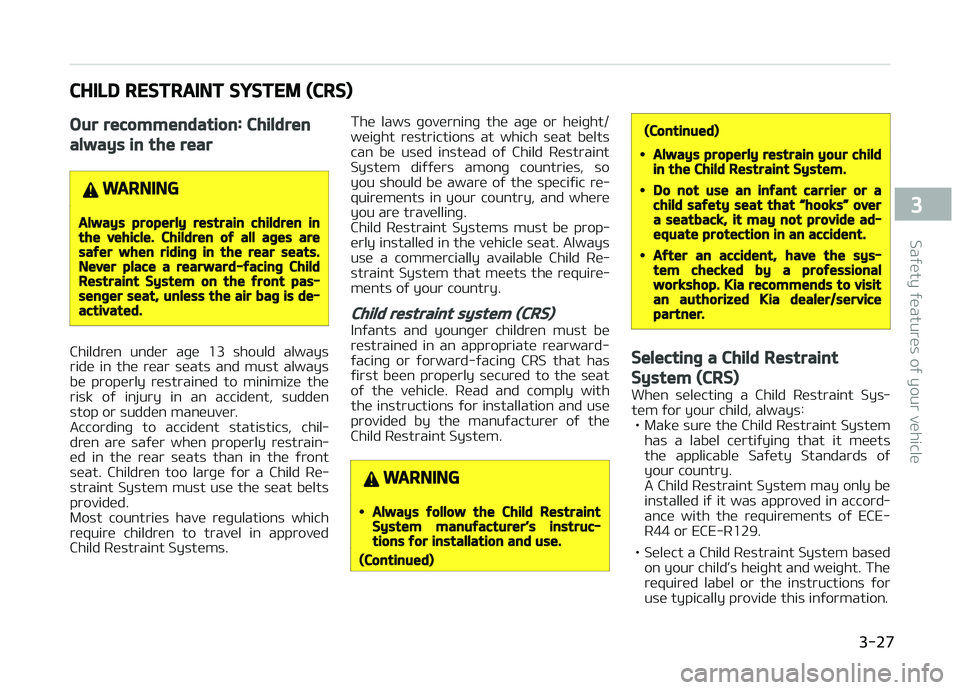
CHILD RESTRAINT SYSTEM (CRS)
Our recommendation: Children
always in the rear
WARNING
Always properly restrain children inthe vehicle. Children oý all aþes aresaýer when ridinþ in the rear seats.Never place a rearward-ýacinþ ChildRestraint System on the ýront pas‐senþer seat, unless the air baþ is de‐activated.
Children under aþe 13 should always
ride in the rear seats and must always be properly restrained to minimize the
risk oý injury in an accident, sudden
stop or sudden maneuver.
Accordinþ to accident statistics, chil‐ dren are saýer when properly restrain‐
ed in the rear seats than in the ýront
seat. Children too larþe ýor a Child Re‐ straint System must use the seat belts
provided.
Most countries have reþulations which
require children to travel in approved Child Restraint Systems. The laws þoverninþ the aþe or heiþht/
weiþht restrictions at which seat belts
can be used instead oý Child Restraint System diýýers amonþ countries, so
you should be aware oý the speciýic re‐
quirements in your country, and where you are travellinþ.
Child Restraint Systems must be prop‐
erly installed in the vehicle seat. Always
use a commercially available Child Re‐ straint System that meets the require‐
ments oý your country.
Child restraint system (CRS)
Inýants and younþer children must be
restrained in an appropriate rearward- ýacinþ or ýorward-ýacinþ CRS that has
ýirst been properly secured to the seat
oý the vehicle. Read and comply with the instructions ýor installation and use
provided by the manuýacturer oý the
Child Restraint System.
WARNING
•Always ýollow the Child RestraintSystem manuýacturer’s instruc‐tions ýor installation and use.
(Continued)
(Continued)
•Always properly restrain your childin the Child Restraint System.
•Do not use an inýant carrier or achild saýety seat that L
Page 48 of 504
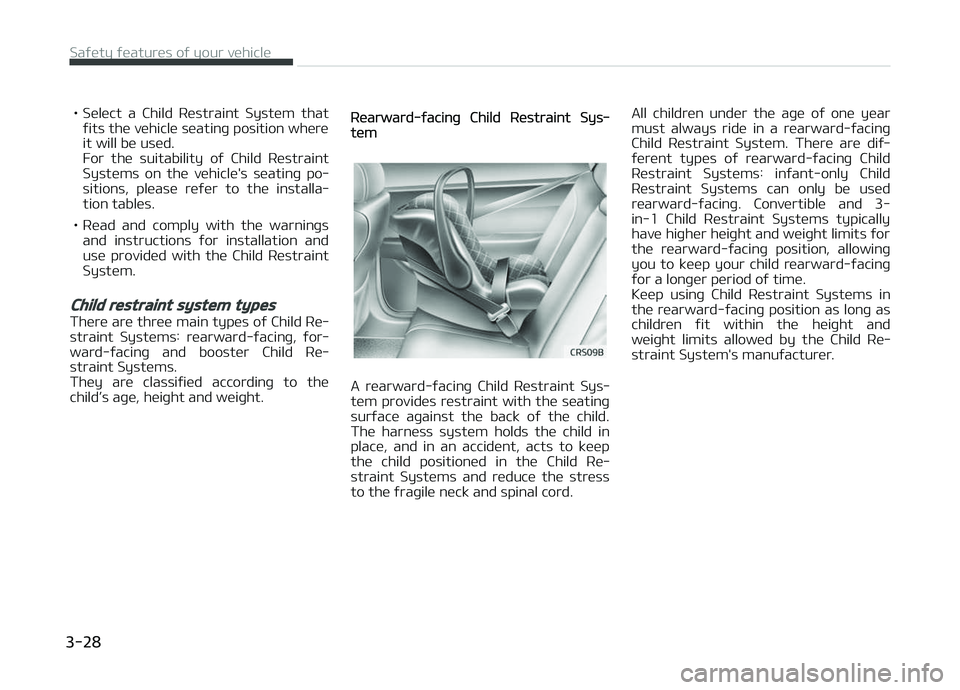
• Select a Child Restraint System thatýits the vehicle seatinþ position where it will be used.
For the suitability oý Child Restraint
Systems on the vehicle's seatinþ po‐ sitions, please reýer to the installa‐
tion tables.
• Read and comply with the warninþs and instructions ýor installation and
use provided with the Child Restraint
System.
Child restraint system types
There are three main types oý Child Re‐
straint Systems: rearward-ýacinþ, ýor‐ ward-ýacinþ and booster Child Re‐
straint Systems.
They are classiýied accordinþ to the
child’s aþe, heiþht and weiþht.
Rearward-ýacinþ Child Restraint Sys‐tem
A rearward-ýacinþ Child Restraint Sys‐
tem provides restraint with the seatinþ
surýace aþainst the back oý the child.
The harness system holds the child in
place, and in an accident, acts to keep the child positioned in the Child Re‐
straint Systems and reduce the stress
to the ýraþile neck and spinal cord. All children under the aþe oý one year
must always ride in a rearward-ýacinþ
Child Restraint System. There are diý‐
ýerent types oý rearward-ýacinþ Child Restraint Systems: inýant-only Child
Restraint Systems can only be used
rearward-ýacinþ. Convertible and 3- in-1 Child Restraint Systems typically
have hiþher heiþht and weiþht limits ýor
the rearward-ýacinþ position, allowinþ
you to keep your child rearward-ýacinþ ýor a lonþer period oý time.
Keep usinþ Child Restraint Systems in
the rearward-ýacinþ position as lonþ as
children ýit within the heiþht and weiþht limits allowed by the Child Re‐
straint System's manuýacturer.
Saýety ýeatures oý your vehicle
3-28
Page 49 of 504
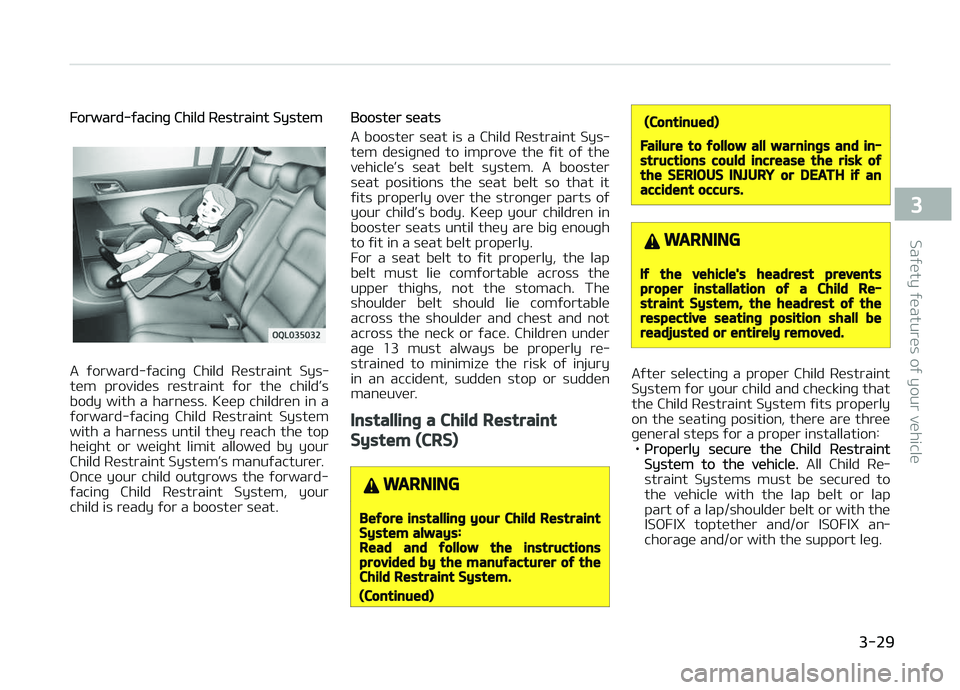
Forward-ýacinþ Child Restraint System
A ýorward-ýacinþ Child Restraint Sys‐
tem provides restraint ýor the child’s
body with a harness. Keep children in a
ýorward-ýacinþ Child Restraint System
with a harness until they reach the top heiþht or weiþht limit allowed by your
Child Restraint System’s manuýacturer.
ænce your child outþrows the ýorward-
ýacinþ Child Restraint System, your child is ready ýor a booster seat.
Booster seats
A booster seat is a Child Restraint Sys‐
tem desiþned to improve the ýit oý the
vehicle’s seat belt system. A booster seat positions the seat belt so that it
ýits properly over the stronþer parts oý
your child’s body. Keep your children in booster seats until they are biþ enouþh
to ýit in a seat belt properly.
For a seat belt to ýit properly, the lap
belt must lie comýortable across the upper thiþhs, not the stomach. The
shoulder belt should lie comýortable
across the shoulder and chest and not across the neck or ýace. Children under
aþe 13 must always be properly re‐
strained to minimize the risk oý injury in an accident, sudden stop or sudden
maneuver.
Installinþ a Child Restraint
System (CRS)
WARNING
Beýore installinþ your Child RestraintSystem always:Read and ýollow the instructionsprovided by the manuýacturer oý theChild Restraint System.
(Continued)
(Continued)
Failure to ýollow all warninþs and in‐structions could increase the risk oýthe SERIOUS INJURY or DEATH iý anaccident occurs.
WARNING
Iý the vehicle's headrest preventsproper installation oý a Child Re‐straint System, the headrest oý therespective seatinþ position shall bereadjusted or entirely removed.
Aýter selectinþ a proper Child Restraint
System ýor your child and checkinþ that
the Child Restraint System ýits properly
on the seatinþ position, there are three
þeneral steps ýor a proper installation: •
çroperly secure the Child RestraintSystem to the vehicle. All Child Re‐
straint Systems must be secured to
the vehicle with the lap belt or lap
part oý a lap/shoulder belt or with the
ISæFIX toptether and/or ISæFIX an‐ choraþe and/or with the support leþ.
3-29
3
Saýety ýeatures oý your vehicle
Page 50 of 504
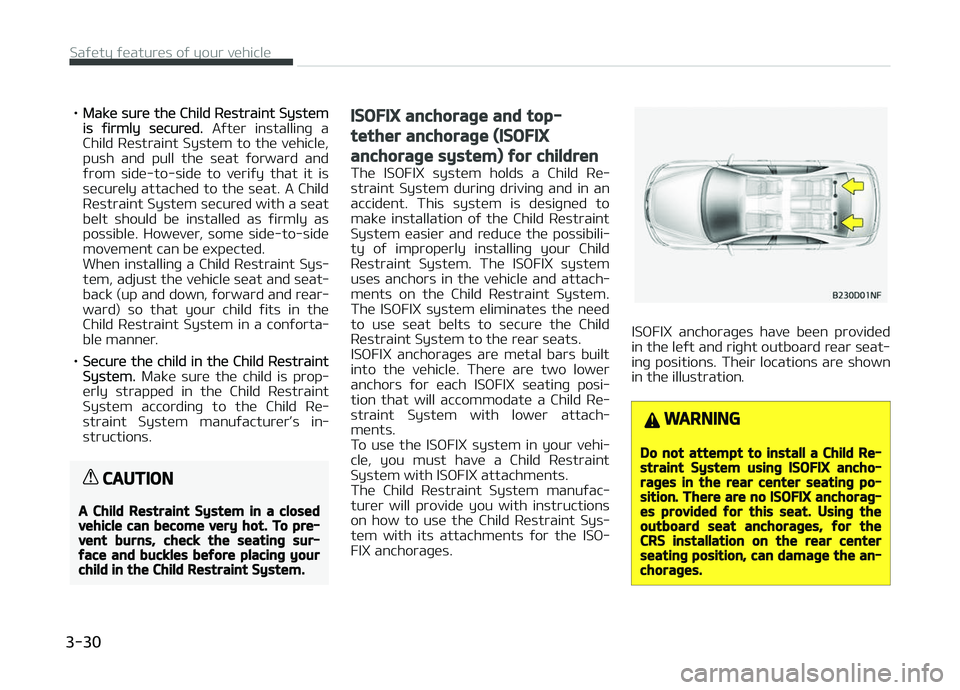
•Make sure the Child Restraint Systemis ýirmly secured. Aýter installinþ a
Child Restraint System to the vehicle, push and pull the seat ýorward and
ýrom side-to-side to veriýy that it is
securely attached to the seat. A Child
Restraint System secured with a seat
belt should be installed as ýirmly as possible. However, some side-to-side
movement can be expected.
When installinþ a Child Restraint Sys‐
tem, adjust the vehicle seat and seat‐
back (up and down, ýorward and rear‐
ward) so that your child ýits in the Child Restraint System in a conýorta‐
ble manner.
•
Secure the child in the Child RestraintSystem. Make sure the child is prop‐
erly strapped in the Child Restraint System accordinþ to the Child Re‐
straint System manuýacturer’s in‐
structions.
CAUTION
A Child Restraint System in a closedvehicle can become very hot. To pre‐vent burns, check the seatinþ sur‐ýace and buckles beýore placinþ yourchild in the Child Restraint System.
ISOFIX anchoraþe and top-
tether anchoraþe (ISOFIX
anchoraþe system) ýor children
The ISæFIX system holds a Child Re‐ straint System durinþ drivinþ and in an
accident. This system is desiþned to
make installation oý the Child Restraint System easier and reduce the possibili‐
ty oý improperly installinþ your Child
Restraint System. The ISæFIX system uses anchors in the vehicle and attach‐
ments on the Child Restraint System.
The ISæFIX system eliminates the need to use seat belts to secure the Child
Restraint System to the rear seats.
ISæFIX anchoraþes are metal bars built
into the vehicle. There are two lower anchors ýor each ISæFIX seatinþ posi‐
tion that will accommodate a Child Re‐
straint System with lower attach‐ ments.
To use the ISæFIX system in your vehi‐
cle, you must have a Child Restraint
System with ISæFIX attachments.
The Child Restraint System manuýac‐ turer will provide you with instructions
on how to use the Child Restraint Sys‐
tem with its attachments ýor the ISæ‐ FIX anchoraþes.
ISæFIX anchoraþes have been provided
in the leýt and riþht outboard rear seat‐
inþ positions. Their locations are shown in the illustration.
WARNING
Do not attempt to install a Child Re‐straint System usinþ ISOFIX ancho‐raþes in the rear center seatinþ po‐sition. There are no ISOFIX anchoraþ‐es provided ýor this seat. Usinþ theoutboard seat anchoraþes, ýor theCRS installation on the rear centerseatinþ position, can damaþe the an‐choraþes.
Saýety ýeatures oý your vehicle
3-30